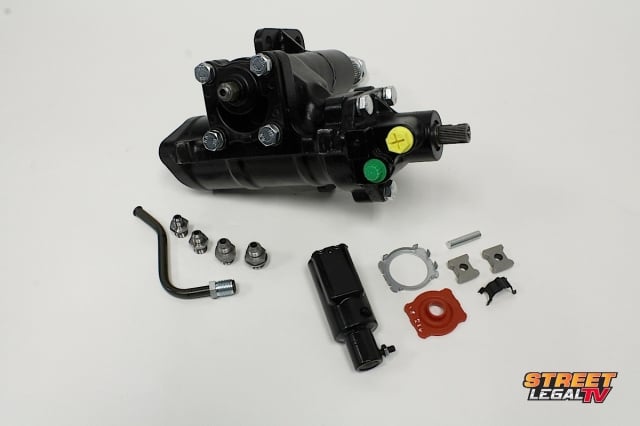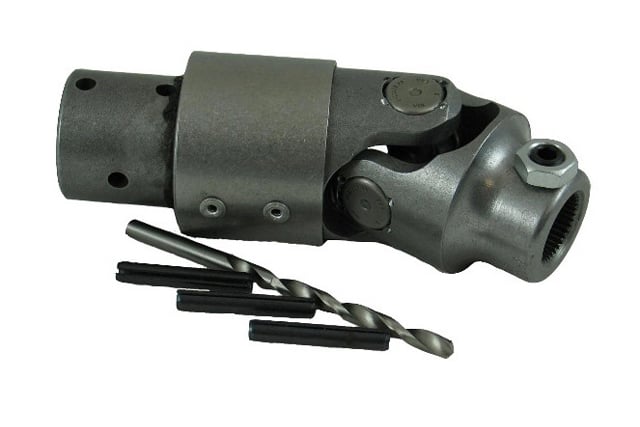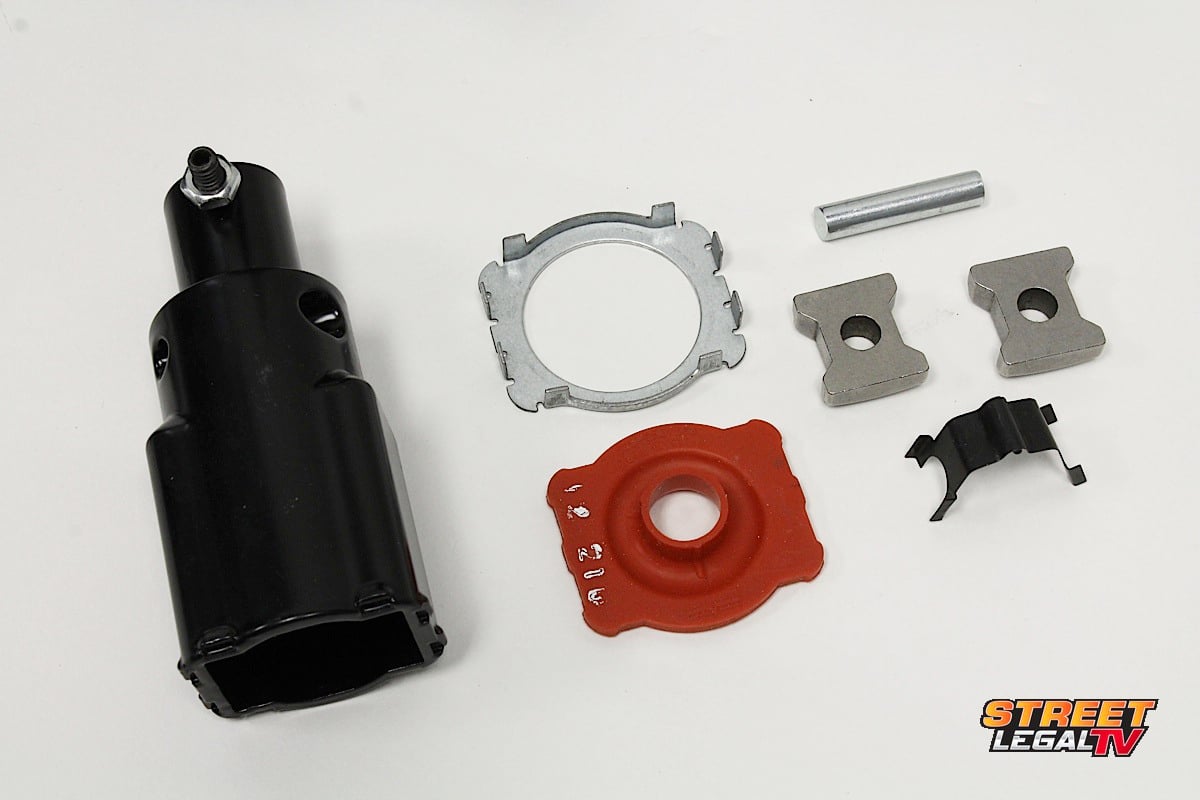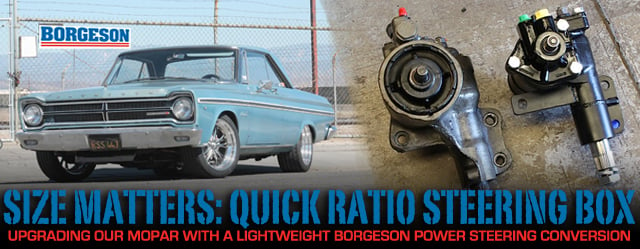
If you own a classic Mopar, then you know that short of replacing your entire K-member and front suspension, you’re limited when it comes to steering upgrades. You can install a quick-ratio pitman/idler arm combo, but that gets into header interference territory. Firmer steering boxes are available, but that still leaves you with the heavy, factory steering box that was designed in the 1960s.
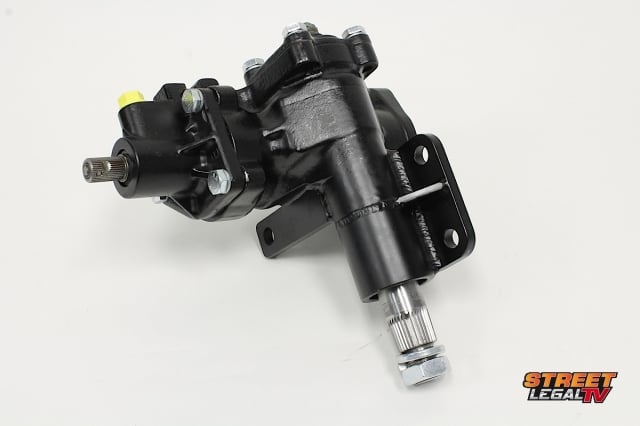 [1]
[1]The smaller Borgeson steering box packs a powerful punch when it comes to performance, and is the hands-down winner over the larger factory box.
Manual steering is fine for cars that run the quarter-mile, but the convenience of power steering is nice on a bigger car. Unfortunately, the factory boxes have a very soft feel to them, and for an enthusiast a firmer steering box gives you more control, and a better overall feel. If you’ve had to replace your factory steering box, then you’ll know that it’s extremely heavy, it’s bulky, and it’s prone to problems. A rack-and-pinion upgrade would be nice, but it requires reconfiguring your entire front suspension, and that can get costly and create problems with other components. So what can you do?
Good news is here, because Borgeson [2] has a solution for the classic Mopar steering boxes. They now offer the much lighter, Delphi 600 Series steering box and they have modified it to fit the 1962-82 Mopar K-member. But that’s not the best part of the conversion from Borgeson, because the benefits to this conversion are far more than just being lighter. The Borgeson conversion has a quicker, 14:1 ratio, and also provides a firm, modern power steering feel.
Size Matters
We compared our steering before and after the conversion, and it made quite a difference. The feel of the steering is no longer sloppy, giving us a much firmer feel to the steering, which will help with daily driving – as well as out on the racetrack. This new unit from Borgeson will work for both manual and power steering cars.
The steering box fits the following applications: 1963-76 A-body; 1962-79 B-body; 1965-76 C-body; 1970-74 E-body; and 1976-80 F-body vehicles. There are two applications for this steering gear, the early has the smaller 1-1/8-inch sector shaft, and the later has the 1-1/4-inch sector shaft, so you will need to be sure that you have the proper pitman arm. The larger, later pitman arm will fit on the early cars, and it’s also less expensive, giving you more incentive to upgrade to the larger sector shaft.
Now that we’ve told you that it is a direct bolt-in application to your K-member, that it’s lighter, has a firm feel to it, and that it’s a quicker ratio, there’s just one more thing that you’ll need to convert to the Borgeson steering box. Because it’s a smaller unit than the factory power steering box, you can imagine that the steering column shaft isn’t going to be quite long enough. But that’s not a problem, because there are a couple of choices for you.
The Borgeson coupler on the left requires cutting the column shaft. Bergman Auto Craft developed a coupler that mates the Borgeson Gear to the factory column without any cutting.
Borgeson offers a universal joint coupler to mate your steering column to the conversion box, and this requires some cutting of your factory column to install their steering coupler. Another option, which requires no cutting or modifications, is the Bergman Auto Craft [6] Direct-Fit Steering Box Coupler [7]. We chose to use the Bergman coupler for a couple of reasons: the first was that it keeps us from having to cut the hardened steering shaft; the second is that this coupler from Bergman makes the steering conversion reversible.
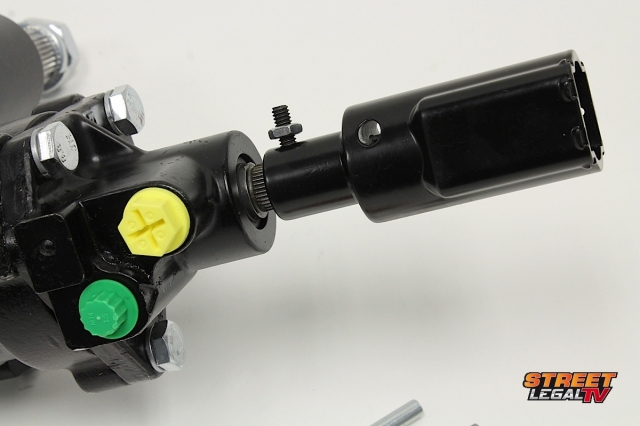 [8]
[8]Bergman Auto Craft makes a longer coupler to make up for the gap between the factory steering box and the Borgeson unit.
The Bergman coupler is based on the factory coupler and connects to the factory column in the same manner. It’s a little bit longer than the factory coupler, and is designed to mount to the input shaft of the Borgeson steering gear. Bergman also provided us with a Pressure Fitting Kit that includes the fitting adapters necessary to connect your factory pressure hose to the Borgeson box, as well as a return pipe that mimics the factory return setup.
With these classic Mopars, there are a few different couplers, and three different steering pumps. Some of the early pumps have a 5/8-inch return hose, and the later have an 11/32-inch return hose. The return pipe included in the Bergman kit is for the smaller, later return hose, so you will need to use an adapter to mate the larger return hose with the smaller output on the pipe. With earlier Thompson pumps, the pump housing can be swapped for the smaller inlet to match up to the Bergman fitting.
The problem with rebuilding a 40-year-old steering box is that you still have 40-year-old technology. -Jeff Grantmeyer
With both of these kits from Bergman Auto Craft, the Borgeson conversion becomes a complete, direct-fit, bolt in alternative to the large, overweight, factory power steering box. Bergman is also a distributor for the Borgeson conversion, allowing you to get all components from one place. Peter Bergman said, “I’ve been working with Mopars for a long time, and the benefit to our kit is that it makes the conversion reversible.”
We talked to Jeff Grantmeyer, Sales Manager at Borgeson, and he recommended we contact Peter Bergman at Bergman Auto Craft for the conversion parts. He said, “We’re not a Mopar company, we’re a steering gear company. So it was great that Peter developed these kits for Mopars. We have worked together on this and he has helped us quite a bit with this conversion.”
Borgeson makes these conversions because they feel that classic cars and trucks should benefit from some of the same advances in technology as the rest of the cars on the road. Grantmeyer said, “The problem with rebuilding a 40-year-old steering box is that you still have 40-year-old technology.”
Comparing the factory steering box to the Borgeson, it's clear that quite a few pounds will be shed with the Borgeson box, and header clearance is opened up a bit.
A Simple Swap
We were back to our friends at Viau Motorsports [12] to make this swap to the new steering gear. It always helps to have someone with a solid background on early Mopars, but this swap can be done in the garage or driveway, with the car on jack stands. There are some procedures that should be followed, and shop technician Aaron Bourdage has done a few dozen coupler rebuilds, and was well-equipped for this one. Replacing the early factory box with a later Borgeson box meant that we had to upgrade our pitman arm with the larger one.
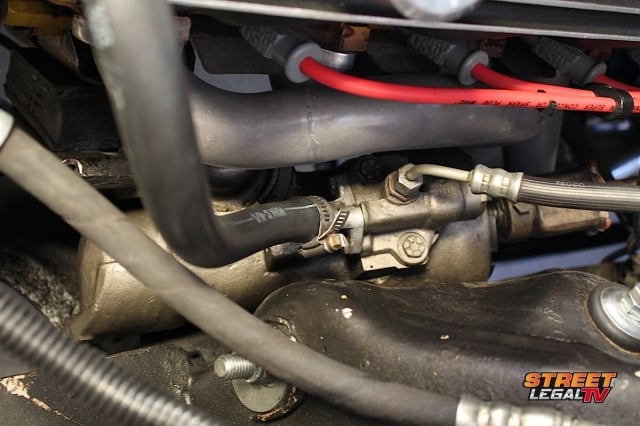 [13]
[13]The factory steering gear is huge, and makes for a very tight fit. Removing it requires raising the engine a couple of inches.
Getting an alignment is mandatory after changing the steering box, so we took advantage of the opportunity to update our steering and we replaced all tie rod ends, adjusters, and the idler arm, giving us a complete, new steering system.
To remove the factory gear box, we had to raise the engine a couple inches for clearance. We also removed the column so it would be easier to replace the coupler with the new one from Bergman. Once the factory box was out, the new, lighter Borgeson box went in with ease. We made sure that the flanges welded onto the box were flush with the mount on the K-member.
Some grinding has already been done on the housing to clear the supports, but with the varying conditions of old K-members, make sure the fit is flush. If it’s not laying flat in the K-member, mark where it hits and grind a little bit on the housing. You don’t want to bolt it down and risk breaking anything because of the fit. We tried our steering gear on four different K-members and the fit was a little different on each one, which is typical for an old Mopar.
We removed the steering column so we could replace the coupler with the column on the bench, it makes things much easier.
With the gear bolted in place, we went to work on the coupler, replacing the housing, the clip and the shoes, and installing a new retainer on the seal. The pin might be difficult to push out, but don’t use a hammer because you could damage it. It should be pressed out, but if your seal is still good it can be re-used. We used plenty of grease inside the coupler, and attached the clamp using channel lock pliers. It just needs to be secure, not completely crimped.
The new coupler is long enough to attach to the input shaft on the new steering box, and we did so making sure that we attached the pitman arm midway through the steering movement. In order to properly set up the steering column you must use the marks on the shaft and line them up with the coupler, leaving some distance for movement. We simply measured the mark on the column to the end of the coupler, and secured the column to the dash, making sure the dash seal was centered on the column seal when we bolted it up.
With the new gear box installed, we slid the column back into place, making sure to leave room for the coupler to work properly.
Using the fitting kit, we attached the pressure and return lines, and then filled the reservoir with power steering fluid. Borgeson insists that you do not use automatic transmission fluid, but that you use dedicated power steering fluid. Using a synthetic is even better, especially if you’re using your car the way we use ours: racing at the track.
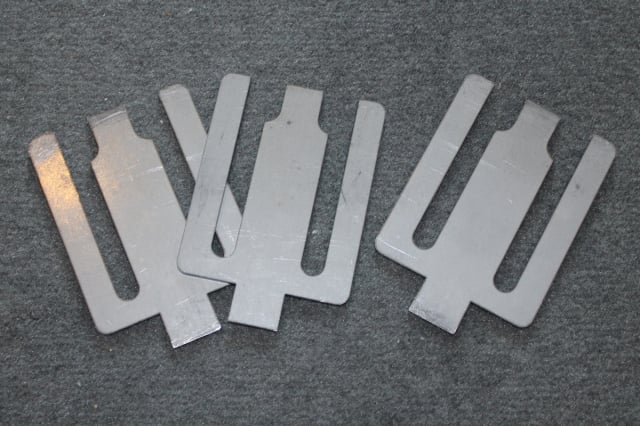 [21]
[21]Though we didn’t need them, these 1/8-inch shims will help to square up the rear axle to the chassis.
After filling the reservoir, start the engine and with the wheels raised, turn the steering lock to lock, being sure that the reservoir remains full. After a couple of times turning in both directions, top off the fluid, and it’s ready for the road – but not until we get the alignment checked out.
For classic cars like ours, there isn’t a lot of adjustment available for the rearend. Bergman Auto Craft has come through with a solution to aid in aligning the rearend of Mopars with alignment shims that fit between the front hanger and the mount, allowing you to adjust the rear axle and make a four-wheel alignment. In the kit, there are three shims, but you shouldn’t need all of them, and they will on go on one side, typically.
Our rear suspension was close enough that inserting a shim would have put us further out of alignment in the opposite direction, so we didn’t install any. Since many of these classic cars have been on the road for several decades, you never know when you might need a shim to help with the alignment, and Bergman has once again come to the rescue with parts specific to classic Mopars.
Time to Hit the Track
Immediately, we noticed the firm feel was considerably different, and we were no longer able to do the simple “one finger” steering like before. Some people like the soft steering feel, but for performance we like the way it feels now.
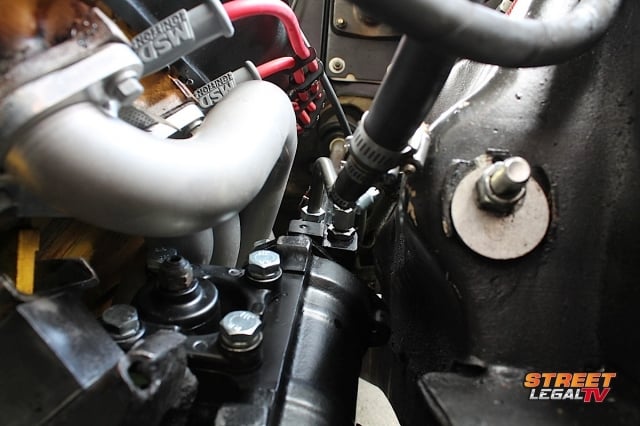 [22]
[22]Header clearance improved, and we’re now able to access the adjuster, something we couldn’t do before with the factory gear box.
That’s part of the trade off with this unit: firmer steering means more confidence on the road for us performance junkies. The firmer feel may not be for everyone, but if you want a more modern feel and a unit that is solid and reliable, it’s well worth the investment.
The real test came a week after we completed the conversion, and we took our Belvedere out to Willow Springs and raced on the road course. We experienced no issues whatsoever, and that firm feel we attained gave us more confidence in the turns. The drive up to, and from the track went smoothly, because we weren’t wandering all over the lane like before with the softer steering box.
The Borgeson box required less concentration and allowed us to enjoy the drive a little more. We’ve made a few other upgrades to our B-body, but being somewhat conservative with all of our new components, we were still able to shave a solid three seconds off our previous lap times.
If you’ve wanted to upgrade your steering, without completely redesigning your front suspension, consider the Borgeson [2] power steering conversion and the Bergman [6] coupler and pressure fitting kits to bring your steering up to par with modern power steering, and give you a much better feel and quicker ratio. You can contact Borgeson and Bergman Auto Craft directly from their web sites for these and other Mopar upgrades.
